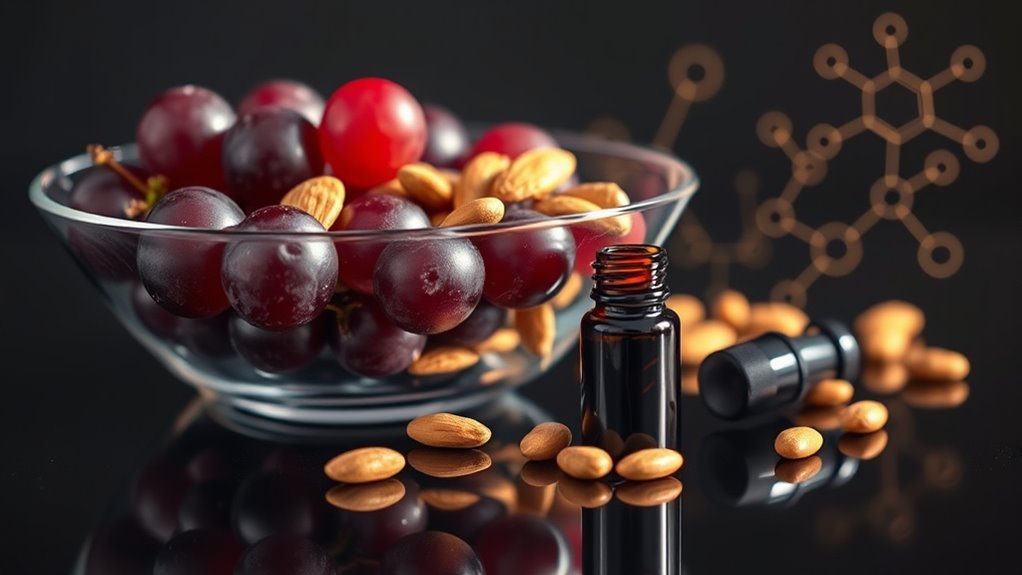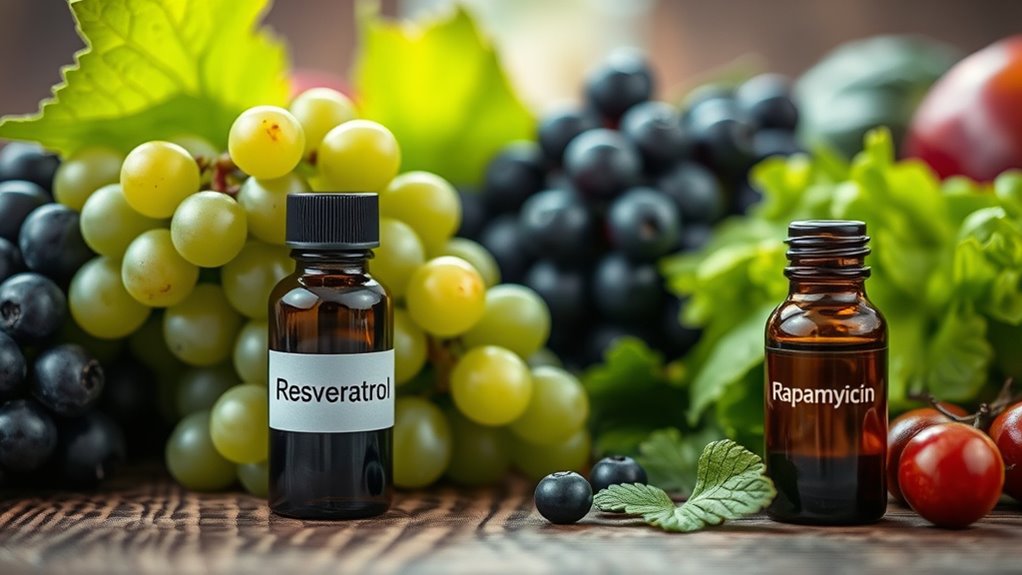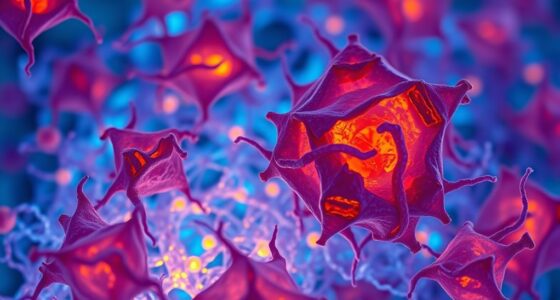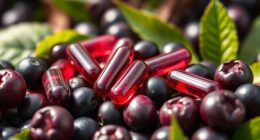Caloric restriction mimetic compounds like resveratrol and rapamycin imitate the benefits of reducing calorie intake, supporting a longer, healthier life. Resveratrol activates sirtuins, boosting DNA repair and energy balance, while rapamycin inhibits the mTOR pathway to enhance cellular cleanup. Other promising options include natural plant extracts and synthetic drugs that target these pathways. To discover how these compounds work and their potential risks, keep exploring—they hold exciting possibilities for aging health.
Key Takeaways
- Caloric restriction mimetics activate pathways such as sirtuins, mTOR, and AMPK to replicate the health benefits of calorie reduction.
- Resveratrol stimulates sirtuins and AMPK, promoting mitochondrial health and metabolic regulation.
- Rapamycin inhibits mTOR, enhancing autophagy and cellular repair to extend lifespan.
- Natural plant extracts and synthetic compounds target aging pathways to reduce inflammation, oxidative stress, and cellular decline.
- Combining these compounds with lifestyle practices may optimize healthspan and longevity benefits.
Understanding Caloric Restriction and Its Benefits

Have you ever wondered why eating less can sometimes lead to a longer, healthier life? That’s because caloric restriction, which involves reducing calorie intake without malnutrition, has been linked to lifespan extension in multiple studies. By limiting calories, you activate cellular pathways that improve metabolic efficiency and reduce inflammation, both of which promote longevity. caloric restriction doesn’t mean starving yourself; instead, it encourages mindful eating and portion control. This practice can help delay age-related diseases like heart disease, diabetes, and neurodegeneration. Researchers have observed that caloric restriction enhances lifespan in animals and shows promising signs in humans. Additionally, understanding the role of digital literacy in health education can empower individuals to make informed lifestyle choices. Understanding this connection helps you grasp how reducing calorie intake can be a powerful tool for promoting long-term health and longevity. Moreover, ongoing research into caloric restriction mimetics aims to develop compounds that mimic these benefits without the need for dietary restrictions.
How Mimetic Compounds Activate Longevity Pathways

You can activate longevity pathways by targeting key molecular mechanisms like sirtuin enzymes, which regulate aging-related processes. Mimetics also modulate the mTOR pathway, balancing cell growth and repair, while enhancing AMPK signals to improve energy efficiency. Together, these actions mimic the effects of caloric restriction, promoting healthier aging. Additionally, some sleep solutions for new parents suggest that proper rest and recovery can support cellular health and longevity. Incorporating well-being tips such as stress reduction and adequate sleep can further enhance the effectiveness of these compounds. Understanding how molecular pathways interact provides insight into optimizing interventions for longevity.
Sirtuin Activation Mechanisms
How do caloric restriction mimetic compounds enhance longevity? They activate sirtuins, a family of proteins that promote healthy aging. These compounds influence sirtuin regulation by increasing NAD+ levels, which are essential for sirtuin activity. Enhanced NAD+ metabolism boosts sirtuin function, supporting DNA repair, mitochondrial health, and metabolic balance. For example, resveratrol directly stimulates sirtuins, mimicking the effects of caloric restriction. Here’s a quick overview:
| Mechanism | Effect |
|---|---|
| NAD+ boost | Enhances sirtuin activity |
| Sirtuin regulation | Promotes longevity-related processes |
| NAD+ metabolism | Supports energy and repair functions |
Additionally, understanding how sirtuin activation impacts cellular health can provide insights into developing effective longevity therapies. This understanding is key to designing caloric restriction mimetics that can safely promote healthy aging without drastic dietary changes. Recognizing the importance of NAD+ levels in these processes offers promising avenues for future research.
Mtor Pathway Modulation
Mimetic compounds influence the mTOR pathway by directly or indirectly inhibiting its activity, which is crucial for regulating growth, metabolism, and aging. These compounds act as mTOR inhibitors, reducing nutrient sensing signals that promote cell growth. By dampening mTOR activity, they help mimic the effects of caloric restriction, promoting cellular repair and longevity. Rapamycin is a well-known mTOR inhibitor that effectively suppresses mTOR complex 1, leading to decreased protein synthesis and enhanced autophagy. Other compounds, like resveratrol, indirectly modulate mTOR signaling through upstream pathways, contributing to improved metabolic health. This targeted modulation of nutrient sensing pathways is a key strategy to activate longevity mechanisms and extend lifespan, making mTOR pathway modulation a cornerstone of caloric restriction mimetics. Hackathons can serve as innovative platforms for developing and testing new compounds or therapies targeting these pathways, fostering collaboration among researchers and entrepreneurs dedicated to longevity research.
AMPK Signal Enhancement
Activation of the AMP-activated protein kinase (AMPK) pathway is a central mechanism through which caloric restriction mimetics promote longevity. When activated, AMPK triggers metabolic reprogramming, shifting cells toward energy-efficient processes that support cellular health. This pathway’s activation enhances the expression of genes involved in mitochondrial biogenesis, antioxidant defenses, and autophagy, all crucial for longevity. Mimetic compounds like resveratrol and metformin directly stimulate AMPK, amplifying these beneficial gene expression changes. By boosting AMPK activity, you encourage a more sustainable energy balance within cells, reducing oxidative stress and fostering improved metabolic health. This activation plays a key role in mimicking the effects of caloric restriction, ultimately supporting longevity and healthy aging. Additionally, the integration of AI in mobile devices is projected to redefine user interactions, potentially influencing health and wellness technologies in the future. Furthermore, advancements in molecular biology are continuously uncovering new compounds that target these longevity pathways, broadening the potential for anti-aging interventions.
Resveratrol: Nature’s Resilience Booster

Have you ever wondered how certain natural compounds can enhance your body’s resilience to aging? Resveratrol, a remarkable polyphenol, is known for its potential to promote longevity and health. Its chemistry involves a stilbene structure that interacts with cell pathways to activate protective mechanisms. Resveratrol sourcing primarily comes from grapes, berries, and peanuts, making it accessible through diet or supplements. This compound stimulates sirtuins, improves mitochondrial function, and reduces inflammation, all of which bolster your resilience against age-related decline. Its natural origin and biological activity make it a popular choice in the quest for caloric restriction mimetics. By harnessing resveratrol’s chemistry and sourcing, you can potentially support your body’s defenses and promote healthy aging.
Rapamycin: From Immunosuppressant to Longevity Agent

While resveratrol offers promising benefits in promoting healthy aging, another compound has garnered attention for its powerful effects on longevity: rapamycin. Originally developed as an immunosuppressant, rapamycin modulates immune responses, which can help reduce chronic inflammation linked to aging. It also influences cellular senescence, limiting the buildup of dysfunctional cells that impair tissue function. By inhibiting the mTOR pathway, rapamycin promotes autophagy and cellular repair processes, extending lifespan in various organisms. Its ability to balance immune modulation and delay cellular aging makes it a compelling candidate for longevity research. Additionally, understanding the mTOR pathway is crucial to appreciating how rapamycin exerts its effects. Scientists have discovered that manipulating this pathway can mimic some benefits of caloric restriction, providing a promising avenue for aging interventions. Although initially used in transplant medicine, scientists now explore rapamycin’s potential as a longevity agent, aiming to replicate caloric restriction benefits without drastic dietary changes. Research into cellular signaling pathways further supports the potential of rapamycin to promote healthy aging by influencing multiple biological processes.
Other Promising Caloric Restriction Mimetics

You should consider other promising caloric restriction mimetics, including natural plant extracts and synthetic drug candidates. These compounds show potential for mimicking the benefits of caloric restriction without drastic diet changes. Exploring these options could open new avenues for aging and health research. For example, some natural plant extracts are being studied for their ability to activate similar pathways as caloric restriction. Additionally, innovative plant-based compounds are being developed to enhance the efficacy and safety of these mimetics. Understanding self-watering plant pots can provide insights into efficient resource management, paralleling the goal of maximizing health benefits with minimal intervention.
Natural Plant Extracts
Natural plant extracts have garnered attention as promising caloric restriction mimetics due to their bioactive compounds that influence metabolic pathways associated with aging and healthspan. These natural extracts contain plant derived compounds known to modulate processes like inflammation, oxidative stress, and cellular repair. For example, polyphenols and flavonoids found in various plants can activate pathways such as SIRT1 and AMPK, which are linked to longevity. By targeting these pathways, natural extracts may mimic some benefits of caloric restriction without requiring drastic dietary changes. You can find these compounds in foods like berries, green tea, and turmeric. Their ability to promote metabolic health makes natural plant extracts a compelling area of research for aging and age-related diseases. Additionally, research suggests that certain plant extracts can also influence hormonal pathways, contributing to their potential as metabolic enhancers. Furthermore, some natural extracts have shown potential to modulate cellular signaling, which plays a role in aging processes and disease prevention.
Synthetic Drug Candidates
Synthetic drug candidates have emerged as a promising approach to mimic the beneficial effects of caloric restriction. Researchers are exploring innovative methods like gene editing to enhance longevity pathways and improve cellular resilience. Stem cell therapy also plays a role, potentially reversing age-related decline and promoting tissue regeneration without caloric restriction. Combining these techniques with targeted drugs could amplify healthspan benefits, addressing age-associated diseases more effectively. These synthetic compounds aim to activate specific molecular pathways, such as sirtuins and mTOR, similar to natural caloric restriction effects. As science advances, integrating gene editing and stem cell therapies with drug development offers new possibilities for extending healthspan and lifespan, making these synthetic candidates exciting prospects in the search for caloric restriction mimetics.
Mechanisms Behind Their Anti-Aging Effects

Caloric restriction mimetic compounds promote anti-aging effects primarily by activating cellular pathways associated with longevity and stress resistance. These compounds target key processes involved in biological aging, slowing down the progression of cellular senescence. They often activate sirtuins and AMP-activated protein kinase (AMPK), which enhance DNA repair, improve mitochondrial function, and reduce oxidative stress. By modulating these pathways, they help maintain cellular health and delay the onset of age-related decline. Resveratrol, for example, activates SIRT1, promoting genomic stability, while rapamycin inhibits mTOR, a pathway linked to cellular growth and aging. Together, these mechanisms help preserve tissue function, reduce inflammation, and extend lifespan, illustrating how these compounds influence fundamental processes underlying aging and age-associated cellular changes.
Potential Risks and Ethical Considerations

While caloric restriction mimetic compounds hold promise for extending healthspan, they also pose potential risks that warrant careful consideration. One concern is the ethical dilemma surrounding gene editing, which could be used to enhance longevity but may lead to unintended genetic consequences or social inequality. Additionally, these compounds might influence stem cell therapy outcomes, potentially causing abnormal cell growth or tumor formation. There’s also the risk of side effects from long-term use, which remain poorly understood. Ethically, questions arise about access and fairness, as such interventions could widen health disparities. You should weigh these risks carefully, recognizing that advancing these therapies requires transparency, regulation, and ongoing research to ensure safety and equitable application.
Future Directions in Longevity Research

Advances in understanding the biology of aging are paving the way for innovative therapies that could substantially extend healthspan. Researchers are exploring genetic engineering techniques to modify aging-related genes, potentially slowing or reversing age-related decline. Simultaneously, lifestyle interventions like diet, exercise, and stress management remain crucial in promoting longevity. Future research will likely combine these approaches, tailoring personalized strategies to maximize benefits. New compounds and biomarkers are being developed to better predict and monitor aging processes. As scientific insights deepen, you’ll see a shift toward integrated therapies that address both genetic and environmental factors. This holistic approach aims to not only extend lifespan but also improve quality of life, making longevity a tangible goal for more people.
Frequently Asked Questions
Are There Any Natural Dietary Sources Rich in Caloric Restriction Mimetics?
You’re wondering if natural foods contain compounds that mimic caloric restriction benefits. Many plant-based antioxidants and dietary polyphenols, like those in berries, grapes, dark chocolate, and green tea, are rich sources. These substances can activate pathways linked to cellular health and longevity. Including such foods in your diet may provide similar benefits to caloric restriction, leveraging their natural bioactive compounds for improved health and aging.
How Do These Compounds Specifically Influence Cellular Aging Processes?
Ever wonder if tiny molecules can turn back your cellular clock? These compounds target molecular pathways and gene regulation, slowing aging processes. They activate sirtuins or inhibit mTOR, reducing inflammation and oxidative stress. By tweaking these pathways, they promote cellular repair and longevity. So, yes, these compounds act as age-defying agents, making your cells behave as if you’re younger — a real fountain of youth in pill form!
Can Caloric Restriction Mimetics Replace Traditional Calorie Restriction Diets?
You might wonder if caloric restriction mimetics can replace traditional diets. While these compounds offer promising benefits by mimicking calorie restriction’s effects, they’re not yet complete substitutes. Alternative dietary strategies, combined with genetic modification techniques, could enhance longevity, but more research is needed. For now, focusing on balanced nutrition and lifestyle changes remains essential. Mimetics are promising tools, yet they shouldn’t fully replace proven dietary practices.
What Are the Long-Term Safety Profiles of These Compounds?
You’re wondering about the long-term safety of these compounds, focusing on their side effect profiles. While some studies suggest they could offer benefits, you should be cautious. Long-term safety data is limited, and potential side effects may include metabolic disturbances or immune issues. It’s important to consult healthcare professionals before using them regularly, as ongoing research is still evaluating their safety for sustained use.
Are There Ongoing Clinical Trials Testing These Mimetics in Humans?
Ever wonder if these compounds are truly safe? Yes, ongoing human trials are actively testing their efficacy and safety assessments. Researchers are carefully monitoring participants to understand long-term effects and potential risks. These clinical trials aim to determine if mimetics like resveratrol and rapamycin can safely replicate caloric restriction benefits. So, you can stay hopeful—scientists are diligently working to guarantee these compounds are safe before widespread use.
Conclusion
As you explore these promising compounds, ask yourself—are they truly the key to revealing longer, healthier lives? While resveratrol, rapamycin, and others show immense potential, understanding their mechanisms and risks is essential. Will these mimetics become mainstream tools or just scientific curiosities? By staying informed and cautious, you can better navigate the future of longevity research, embracing innovations that could redefine aging itself.









